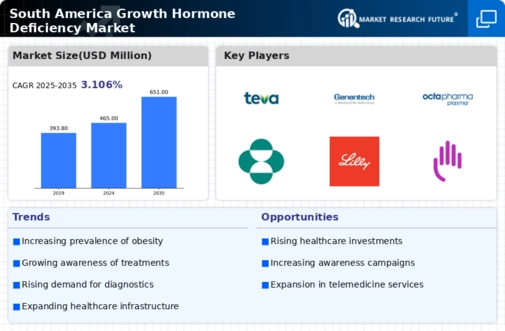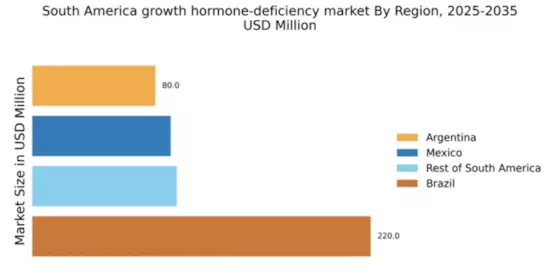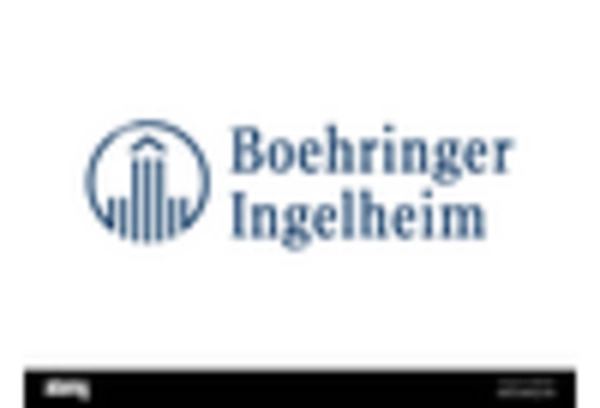Rising Healthcare Expenditure
The increase in healthcare spending across South America is a significant driver for the growth hormone-deficiency market. Governments and private sectors are allocating more resources to healthcare, with expenditures rising by approximately 5% annually in several countries. This trend facilitates better access to treatments and medications for growth hormone deficiency, as well as improved healthcare infrastructure. As a result, patients are more likely to receive timely diagnoses and effective treatments, which in turn stimulates market growth. Additionally, the focus on improving healthcare quality and accessibility is expected to further enhance the growth hormone-deficiency market in the region.
Enhanced Regulatory Frameworks
The establishment of more robust regulatory frameworks in South America is positively influencing the growth hormone-deficiency market. Governments are implementing policies that promote research, development, and approval of new therapies for growth hormone deficiency. These regulatory improvements are designed to ensure patient safety while facilitating faster access to innovative treatments. As a result, pharmaceutical companies are more inclined to invest in the development of new products, knowing that there is a supportive regulatory environment. This trend is expected to drive the growth hormone-deficiency market forward, as more effective therapies become available to patients in need.
Growing Interest in Personalized Medicine
The shift towards personalized medicine is emerging as a key driver for the growth hormone-deficiency market in South America. Tailored treatment plans based on individual genetic profiles and specific health conditions are gaining traction among healthcare providers. This approach not only improves treatment efficacy but also enhances patient satisfaction. As pharmaceutical companies invest in research and development to create personalized therapies, the growth hormone-deficiency market is likely to benefit from the introduction of innovative products. Moreover, the increasing acceptance of personalized medicine among patients and healthcare professionals may lead to a more significant market presence in the coming years.
Technological Advancements in Diagnostic Tools
Innovations in diagnostic technologies are significantly impacting the growth hormone-deficiency market in South America. The introduction of advanced imaging techniques and biomarker identification methods has improved the accuracy and speed of diagnosing growth hormone deficiency. For instance, the use of MRI and genetic testing has become more prevalent, allowing for earlier detection and intervention. This technological evolution not only enhances patient outcomes but also drives market growth as healthcare providers invest in these advanced tools. Furthermore, the increasing collaboration between technology firms and healthcare institutions is likely to lead to the development of more sophisticated diagnostic solutions, thereby expanding the growth hormone-deficiency market.
Increasing Prevalence of Growth Hormone Deficiency
The rising incidence of growth hormone deficiency in South America is a crucial driver for the growth hormone-deficiency market. Recent studies indicate that approximately 1 in 3,000 children may be affected by this condition, leading to a growing demand for diagnostic and therapeutic solutions. As awareness increases among healthcare professionals and the general public, more individuals are likely to seek medical advice, resulting in higher diagnosis rates. This trend is further supported by the increasing number of pediatric endocrinologists in the region, which enhances access to specialized care. Consequently, the growth hormone-deficiency market is expected to expand as healthcare systems adapt to meet the needs of this growing patient population.


















Leave a Comment